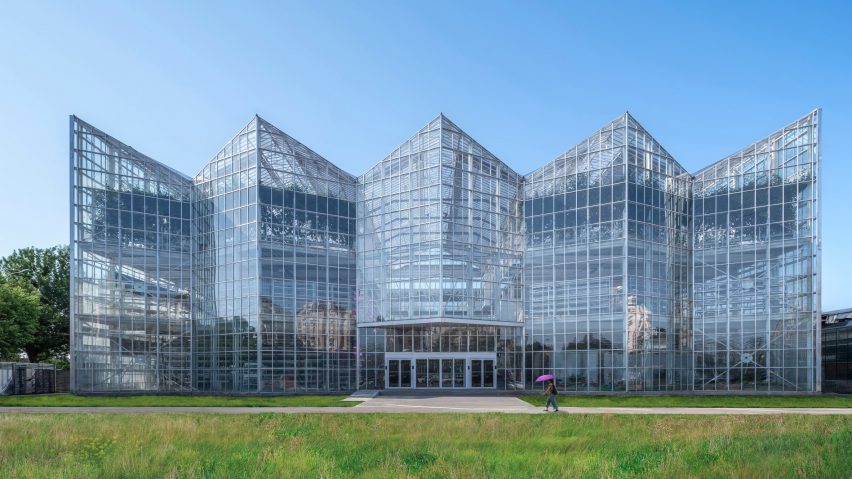Dutch practice Van Bergen Kolpa Architecten has completed Vertical Farm Beijing, an innovation centre for urban fruit and vegetable production housed in a faceted greenhouse.
Created for horticultural company AgriGarden and the Chinese Academy of Agricultural Science (CAAS), the centre was designed to demonstrate to both students and the general public how food can be grown sustainably in an urban environment.
The 3,500-square-metre greenhouse stands at the entrance to the CAAS campus in central Beijing, and Rotterdam-based Van Bergen Kolpa Architecten conceived of it as a new "icon" for the academy.
"To supply millions of inhabitants of China's large metropolises with green and healthy food, its production must be integrated as much as possible in and around the city," explained the studio.
"Vertical Farm Beijing offers a solution in the form of stacked horticulture on a compact footprint – a new type of building for professional cultivation with accessibility to a wide audience that celebrates the central role of food in the city," it continued.
Across three floors, Vertical Farm Beijing was designed to showcase a range of different vertical growing methods and demonstration areas, tied together by an educational route for visitors.
The greenhouse is organised around a full-height atrium into which visitors enter, which has been landscaped with large fruit trees and is overlooked by the shelf-like vertical planting areas of the surrounding space.
On the first and second floors, fruit, berries and leafy vegetables are grown under purple LED lights, which give the building a distinctive glow at night.
"Throughout the day, the bay windows allow refraction-free glimpses inside and out. In the evening, the building, with its various LED light types, shows itself as a beacon in the city," explained the studio.
Above, tomato and cucumber is grown under natural daylight on the third floor, where the zig-zagging steel-framed roof features integrated sun screening and ventilation.
"One of the challenges was to bring together light conditions for different types of cultivation in one building so that both vegetable and fruit cultivation can be experienced in one spatial environment,” said Jago van Bergen, director of Van Bergen Kolpa Architects.
The water used to irrigate and water the plants is recycled and reused, while temperature control is provided passively through evaporative cooling and sunlight.
Van Bergen Kolpa Architecten recently collaborated with Meta Architectuurbureau on the design of Agrotopia, an urban food production centre in Belgium housed in a greenhouse atop an existing market building.
The photography is by Weiqi Jin.

